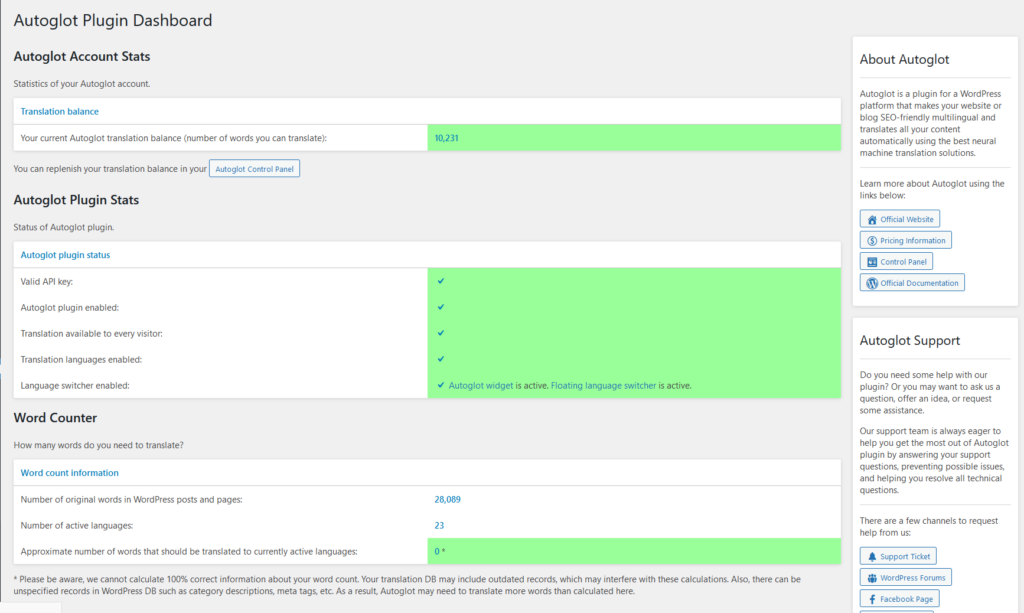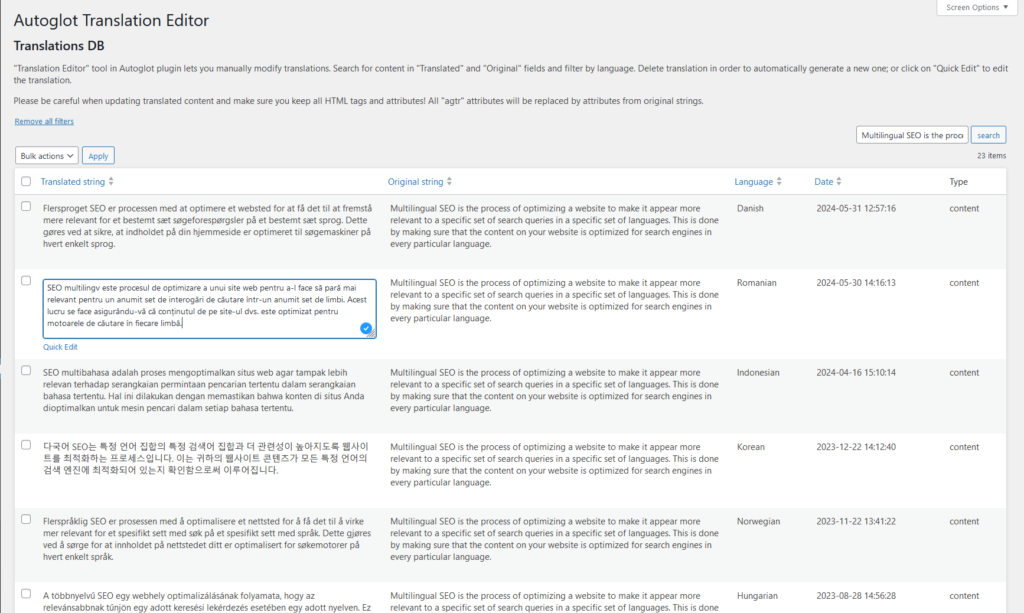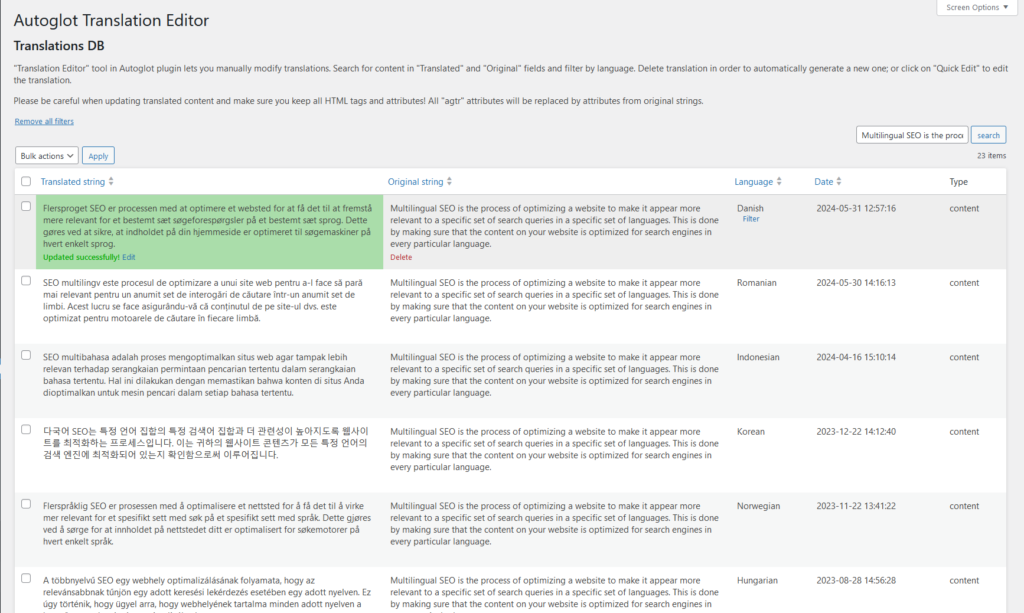
Multilingual websites are essential for reaching a global audience. In today’s interconnected world, having a website that caters to speakers of multiple languages can significantly expand your reach. By offering content in different languages, you’re not just accommodating non-English speakers, but actively inviting them to engage with your brand. This inclusion can lead to a substantial increase in traffic from diverse geographical regions, allowing your business to tap into new markets and demographics.
Introduction
Overview of Multilingual Websites
This article aims to guide you through the process of editing translations in WordPress using post-editing techniques. As the demand for multilingual websites grows, so does the need for accurate and reliable translations. While machine translation has made it easier to translate content quickly, it often requires fine-tuning to ensure the translations are accurate and contextually appropriate. This is where post-editing comes in, bridging the gap between automated translation and human quality standards.
This guide will explore the benefits of post-editing machine translations and how this approach can enhance your multilingual website. By improving the quality of your translations, you can provide a better user experience, foster greater trust with your audience, and ultimately drive more traffic and conversions.
Understanding the Importance of High-quality Translations
Understanding the importance of high-quality translations and learning how to achieve them can give you a competitive edge. As more businesses recognize the value of multilingual websites, those who invest in quality translations will stand out. This guide will provide you with practical steps and tips to enhance your website’s translations, ensuring they meet the needs and expectations of your global audience.
Whether you’re a website administrator, a translator, or a proofreader, this guide will help you enhance your site’s multilingual content and reach a broader audience with confidence.
How to Reach a Diverse Audience?
Benefits of Multilingual Websites
Reaching New Audiences
Multilingual websites enable businesses to connect with non-English speaking customers. The internet is a global platform, and many users prefer or even require content in their native language. By providing multilingual options on your website, you can engage with a wider audience, including those who might have otherwise been excluded due to language barriers. This inclusion can open up new markets, allowing your business to grow its customer base internationally.
Driving Global Traffic
Offering content in multiple languages significantly boosts your site’s global traffic. Search engines prioritize content that meets the needs of various linguistic groups. When your website includes translations, it becomes more visible in search results for those languages, leading to higher organic traffic from different countries. This increased visibility can lead to more visitors, higher engagement rates, and improved SEO rankings.
Improved User Experience
A multilingual website enhances user satisfaction and engagement. Visitors are more likely to stay longer and interact more with a site that communicates in their preferred language. This comfort and ease of access can lead to better user experiences, higher retention rates, and increased chances of conversion. Providing content in multiple languages shows respect and understanding of diverse cultural backgrounds, fostering a stronger connection with your audience.
Competitive Advantage
Having a multilingual website gives you a competitive edge in the global market. Many businesses still operate with monolingual websites, limiting their reach. By offering multilingual content, you stand out from competitors who have not yet adapted to this trend. This differentiation can be crucial in attracting and retaining customers who value the ability to access information in their native language.
Enhanced Brand Image
Multilingual websites contribute to a positive and inclusive brand image. Demonstrating a commitment to catering to a global audience reflects well on your brand, showing that you are forward-thinking and inclusive. This can enhance your reputation, build trust with international customers, and foster brand loyalty.
Expanding your reach to a global audience can lead to increased revenue opportunities. By tapping into international markets, you can attract more customers and potentially increase sales. Multilingual websites make it easier for users from different regions to understand your products or services, which can lead to more conversions and, ultimately, higher revenue.
How To Launch a Successful Multilingual Business Online?
Importance of Machine Translation Post-Editing
Quality Enhancement
Post-editing significantly improves the accuracy and fluency of machine translations. Machine translations, while fast and cost-effective, often lack the nuanced understanding that a human translator brings. They can produce awkward phrasing, grammatical errors, and contextual inaccuracies. By involving a human editor to review and refine these translations, you can ensure that the content is not only correct, but also reads naturally and conveys the intended meaning accurately.
Balancing Speed and Quality
Post-editing offers a balance between the speed of machine translation and the quality of human translation. Pure machine translation is quick but often unreliable, while full human translation is precise but time-consuming and expensive. Post-editing combines the best of both worlds by allowing machine translation to do the heavy lifting initially, followed by human intervention to polish the text. This approach significantly reduces the time and cost compared to full human translation, while still achieving a high standard of quality.
Cost-Effectiveness
Post-editing is a more affordable solution than manual translation from scratch. While hiring professional translators for every piece of content can be costly, using machine translation followed by human post-editing offers a cost-effective alternative. This method leverages the efficiency of technology while ensuring that the final product meets quality standards, making it an ideal solution for businesses with budget constraints.
Consistency
Post-editing ensures consistent use of terminology and style throughout your content. Machine translation systems can sometimes be inconsistent, especially with specialized terminology or brand-specific language. A human editor can ensure that terms are used consistently and appropriately, maintaining the integrity of your brand’s voice across all languages.
Flexibility and Scalability
Post-editing allows for easy updates and scalability. When you need to update your content, machine translation can quickly provide a new version, and a human editor can make the necessary adjustments. This flexibility is particularly valuable for websites that require frequent updates or have a large volume of content to translate. It allows for rapid scaling without compromising on quality.
Enhancing User Experience
High-quality translations enhance the overall user experience. Poorly translated content can confuse and frustrate users, leading to a negative impression of your website and brand. By ensuring your translations are accurate and well-written through post-editing, you provide a smoother and more enjoyable experience for your users, encouraging them to engage more with your content and increasing the likelihood of conversions.
Advantages of Machine Translation Post-Editing
- Post-editing is significantly faster than translating from scratch. By leveraging machine translation to produce an initial draft, human editors can focus their efforts on refining and correcting the content rather than starting from zero. This streamlined process saves time, enabling quicker turnaround times for translated content, which is particularly beneficial for businesses with tight deadlines.
- Post-editing ensures consistent use of terminology and style. Machine translation systems can sometimes struggle with maintaining consistency, especially when dealing with industry-specific jargon or brand-specific language. Human editors can standardize terminology and ensure that the translation aligns with your brand’s voice and style guidelines, providing a coherent and professional final product.
- Post-editing is a cost-effective solution compared to full manual translation. While hiring professional translators to create content from scratch can be expensive, using machine translation followed by post-editing offers a more budget-friendly alternative. This method allows businesses to produce high-quality translations without the significant costs associated with manual translation, making it an ideal option for companies with limited budgets.
- Post-editing provides flexibility for updating and maintaining content. As your website evolves and new content is added, machine translation can quickly generate translations that human editors can then refine. This flexibility is particularly valuable for websites that require frequent updates or manage large volumes of content, ensuring that your multilingual content stays current and accurate.
- Post-editing allows for rapid scaling of translation efforts. For businesses looking to expand their reach into new markets, the ability to quickly and efficiently translate large amounts of content is crucial. By combining machine translation with human post-editing, companies can scale their translation efforts to meet growing demands without compromising on quality.
- High-quality translations enhance the user experience and build trust. Users are more likely to engage with content that is accurately and fluently translated. Poor translations can frustrate and alienate visitors, leading to a negative impression of your brand. By ensuring that your translations are polished and professional through post-editing, you can provide a better user experience, foster trust with your audience, and encourage repeat visits and conversions.
- Post-editing gives businesses a competitive edge in the global market. As more companies recognize the importance of multilingual websites, those that invest in high-quality translations will stand out. Offering well-translated content shows a commitment to international customers and enhances your brand’s reputation, helping you gain an edge over competitors who may not prioritize translation quality.
Guide on Editing Translation in WordPress Using Autoglot
Step 1: Login to WordPress Admin Dashboard
First, log in to your WordPress admin dashboard. This is where you will have access to all the backend features of your website. Make sure you have the necessary permissions to manage plugins and translations.

Navigate to the Autoglot plugin. Once logged in, find the Autoglot plugin in the menu. Click on it to open the plugin’s main interface, where you can access various translation management features.
Step 2: Access the Translation Editor
Proceed to the Translation Editor within the Autoglot plugin. The Translation Editor is your hub for managing your site’s translations. Here, you will see a comprehensive list of all translation records stored in the database.

Utilize the search and filter functions. The Translation Editor includes convenient search and filter by language functions. These tools help you quickly locate specific translation strings, making it easier to manage large amounts of content efficiently.
Step 3: Delete Translation Records
There is an option to delete translation records. If you find any translations that are incorrect or outdated, you can delete these records. Doing so will prompt the system to regenerate new translations, ensuring your content remains accurate and up-to-date.
Step 4: Use the Quick Edit Feature
The most important feature is the Quick Edit button. This button allows site administrators, translators, or proofreaders to manually adjust and modify translations directly. By clicking Quick Edit, you can make immediate changes to the translation text, enhancing accuracy and contextual relevance.

Manually adjust and modify translations as needed. The Quick Edit feature provides a straightforward way to refine translations, ensuring they meet your quality standards and accurately reflect the intended message.
Step 5: Review and Finalize
After editing, Autoglot saves your changes automatically. This step is crucial to ensure that your modifications are applied to the live site. Double-check the edited translations to confirm they are accurate and contextually appropriate before saving.

Review the final translations to ensure consistency and accuracy. It’s a good practice to review all edited translations to ensure they are consistent with your site’s overall language and tone. Make any final adjustments as needed.
Finalize the translation process by conducting a thorough review. This final step ensures that your multilingual content is polished and ready for your global audience. By following these steps, you can efficiently manage and improve translations on your WordPress site using the Autoglot plugin.
Benefits of Autoglot for Clients
- Autoglot offers a highly intuitive and user-friendly interface. Navigating through translation tasks can often be complex, but Autoglot simplifies this process with a clean, organized interface. This makes it easy for users of all technical backgrounds to manage their translation projects efficiently, reducing the learning curve and increasing productivity.
- Autoglot combines the efficiency of machine translation with the precision of human post-editing. The platform integrates advanced machine translation algorithms with tools that allow human editors to refine and improve the initial translations. This hybrid approach ensures that the translations are not only quick but also of high quality, meeting professional standards and providing a more accurate and fluent result.
- The search and filter functions in Autoglot make managing translations straightforward. These features enable users to quickly locate specific translation records, filter by language, and find exactly what they need without having to sift through extensive lists. This functionality is particularly useful for large websites with vast amounts of content, ensuring that users can efficiently manage and edit translations.
- The “Quick Edit” feature allows for rapid adjustments to translations. This tool is designed to let site administrators, translators, or proofreaders make immediate changes to translations with ease. By providing a streamlined way to modify text, the Quick Edit feature saves time and effort, ensuring that updates and corrections can be made swiftly and accurately.
- Autoglot provides flexibility in managing and updating translations. Whether you need to update existing content or add new translations, Autoglot supports easy content management. The ability to delete and regenerate translation records ensures that your multilingual content remains current and accurate, adapting seamlessly to any changes on your site.
- Using Autoglot enhances overall workflow efficiency for translation projects. The platform’s features are designed to streamline the translation process, from initial machine translation to final human post-editing. By integrating these steps into one cohesive system, Autoglot minimizes the time and resources required, allowing businesses to focus more on their core activities while ensuring high-quality translations.
Clients benefit from the increased accuracy, consistency, and efficiency that Autoglot offers. By leveraging Autoglot’s powerful tools, businesses can provide better multilingual content, improving user satisfaction and engagement. The platform’s comprehensive approach to translation management not only enhances the quality of the content but also supports the business’s global reach and growth objectives, making it an invaluable asset for any company looking to expand its international presence.
How to Manage Multilingual Content on WordPress Sites?
Conclusion: Choose Autoglot for Post-Editing of Machine Translation
Advantages of Post-editing Approach
Multilingual websites offer numerous advantages, including expanded reach and improved user experience. By providing content in multiple languages, you can attract a broader audience, enhance engagement, and drive more traffic to your site. Multilingual content demonstrates respect for cultural diversity and helps build trust with international customers.
Post-editing of machine translations significantly enhances the quality of your multilingual content. This process combines the speed of machine translation with the accuracy of human editing, ensuring that translations are fluent, accurate, and contextually appropriate. Post-editing is cost-effective and efficient, providing a balanced approach to translation that meets professional standards without breaking the bank.
Why Autoglot?
Autoglot offers powerful tools to manage and refine translations on your WordPress site. With its user-friendly interface, search and filter functions, and the convenient Quick Edit feature, Autoglot simplifies the process of maintaining high-quality multilingual content. This tool is designed to streamline translation management, making it easier for site administrators, translators, and proofreaders to collaborate and produce polished, professional translations.
Investing in high-quality translations is crucial for businesses aiming to succeed in the global market. By ensuring your content is accurately translated and culturally relevant, you can provide a better user experience, foster trust with your audience, and stand out from competitors. Using tools like Autoglot for post-editing machine translations can help you achieve these goals efficiently and effectively.
Choose Autoglot!
We encourage you to explore Autoglot and its features to enhance your WordPress site’s multilingual content. Start by logging in to your WordPress admin dashboard and navigating to the Autoglot plugin. Follow the steps outlined in this guide to edit and refine your translations, ensuring they meet the highest quality standards.
By leveraging Autoglot, you can improve your site’s global reach and user experience. High-quality translations are key to engaging with a diverse audience and driving international growth. Take the first step today and see the difference that professional, well-managed translations can make for your website and your business.



